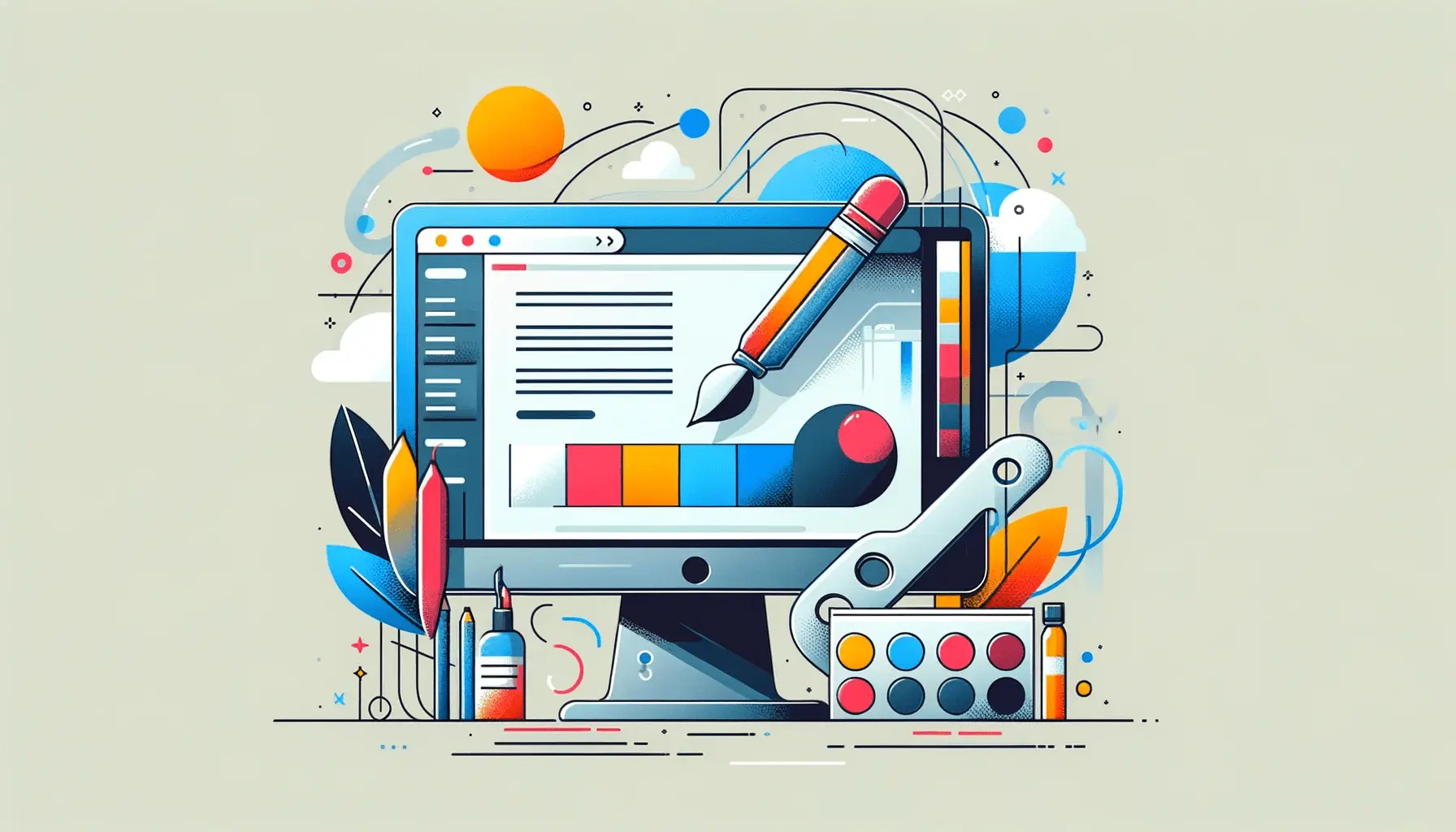Meaningful relationships between users and websites are the paramount element in today’s digital world.
One method of offering such relationships is through the strategic use of illustrations in web design.
You can make interactions easier and more engaging through the use of well-designed visuals effectively.
- The Role of Illustrations in Enhancing User Experience
- Types of Illustrations Usually Used in Web Design
- Best Practices for Website Illustration Integration
- Case Studies: Successful Use of Illustrations in Web Design
- Future Trends: Illustrations Defining Web Design
- Web Design Illustrations: An Answer to Humanizing Interactions
- Frequently Asked Questions on Illustrations in Web Design
The Role of Illustrations in Enhancing User Experience
Illustrations play a pivotal role in shaping the manner in which users perceive and interact with a website.
They are not merely ornaments but also functional tools that guide, inform, and amuse users.
Making It More Visually Appealing and Interactive
First impressions are lasting impressions.
When users reach your site, the visual layout makes an impression on them instantly.
Good, relevant illustrations can:
- Gather Attention: Unconventional and striking illustrations draw users in, encouraging them to explore further.
- Express Brand Personality: Branded illustrations establish a sense of identity for your brand, encouraging familiarity and recall.
- Make Storytelling Better: Visual stories allow for faster transmission of complex ideas, making users more engaged with your content.
By using illustrations that resonate with your target audience, you create a friendly environment that encourages longer interaction.
Enabling Greater User Navigation
Apart from aesthetics, illustrations can significantly improve the usability of your website.
They function as visual cues that guide users through the structure of your site.
For instance:
- Icons and Symbols: Intuitive icons help users easily identify functionalities at a glance, conserving cognitive resources and ensuring smooth navigation.
- Visual Hierarchy: Illustrations can emphasize focal points or calls to action, drawing user attention effectively.
- Interactive Elements: Feedback-giving, engaging visuals like hover effects or animated illustrations make interactions more intuitive.
As long as your site is easy to use for visitors, they’ll be more likely to have a great experience, increasing the chances of achieving your desired outcomes.
Giving Complex Information in Simple Ways
There are situations when presenting complicated information or ideas is difficult.
Illustrations save the day by presenting complexity in simple ways:
- Infographics: Information visualization condenses content into a digestible format, allowing users to grasp insights at a glance.
- Process Diagrams: Step-by-step illustrations guide users through procedures, enhancing comprehension and reducing errors.
- Metaphorical Imagery: Using familiar visuals to depict abstract concepts simplifies the delivery of messages.
By becoming a visual messenger of information, illustrations ensure that users can learn and retain information better.
Adding thoughtful illustrations to your web design not only enhances its appearance but also improves usability, leading to a more pleasant user experience.
As you explore the potential of illustrations, consider how they can be crafted to meet the unique needs and expectations of your audience.
Illustrations are not just decorative elements; they are functional tools that improve user engagement, guide navigation, and simplify complex information.
Types of Illustrations Usually Used in Web Design
Adding the right type of illustrations to your web design can actually make a big difference when it comes to user engagement and conveying your brand’s message effectively.
Let’s discuss some common types of illustrations used in web design:
Custom vs. Stock Illustrations
When you add illustrations to your website, you have two primary options:
- Custom Illustrations: Created specifically for your brand, they ensure uniqueness and coherence with your brand image. They can be used to portray your brand’s personality and values.
- Stock Illustrations: Pre-made illustrations sold or offered for free download. Although cost-effective and convenient, they are not exclusive and may not fully capture your brand’s uniqueness.
Choosing between custom and stock illustrations depends on your budget, timeline, and the desired level of customization for your site.
Icons and Their Functional Uses
Icons are abstract graphical symbols used to convey actions, features, or content.
In web design, they serve several functional uses:
- Navigation: Icons like home, search, or menu guide visitors through the site, enhancing usability.
- Action Indicators: Icons such as download arrows or shopping carts prompt the user to take specific actions.
- Content Categorization: Icons visually indicate different sections or categories, enabling quick recognition of content.
Applying icons in the right manner can simplify user interactions and make your site more accessible.
Data Visualizations and Infographics
Presenting intricate information in a consumable format is necessary for user understanding.
Infographics and data visualizations achieve this by making information visually presentable:
- Data Visualizations: Charts, graphs, and maps that present data trends and patterns make information more readable.
- Infographics: Combining text and images, infographics present information by defining an idea or narrating a story, making complex information engaging and easy to grasp.
Including data visualizations and infographics can enhance the informative value of your website, keeping users engaged and informed.
By selecting and including illustrations with care, you can create a visually appealing and user-friendly website that effectively conveys your brand’s message and engages with your audience.
Selecting the right type of illustration—custom or stock—can significantly impact your website’s uniqueness and branding effectiveness.
Best Practices for Website Illustration Integration
Integrating illustrations into your website can greatly increase user interaction and communicate your brand’s message.
To achieve the most from them, though, it’s important to adhere to best practices that make these visuals functional and beautiful.
Be Consistent with Brand Identity
Consistency with your brand’s identity creates a harmonious user experience.
Keep the following in mind:
- Style Consistency: Ensure that all illustrations share a single style, color palette, and tone that align with your brand personality.
- Purposeful Visuals: Use illustrations to reinforce your brand message and values, helping your audience form a stronger connection.
Consistency in visual elements helps build brand recognition and trust among users.
Optimize for Performance and Load Times
Website performance is critical to retaining users.
Optimizing illustrations contributes to fast loading times and a smooth user experience:
- Utilize Scalable Vector Graphics (SVG): SVGs are lightweight and scale without loss of quality, making them ideal for responsive design.
- Compress Images: Reduce file sizes of raster images without compromising quality to boost load times.
- Lazy Loading: Use lazy loading techniques to delay the loading of off-screen illustrations, improving initial page load performance.
Optimizing illustrations ensures they enhance the user experience instead of slowing it down.
Make It Accessible and Inclusive
Accessible illustrations make your site usable for a wider audience, including individuals with disabilities:
- Alt Text Descriptions: Use descriptive alt text for every illustration to assist screen readers in conveying visual information to visually impaired users.
- Contrast Ratios: Ensure sufficient contrast between illustrations and backgrounds to support users with visual impairments.
- Responsive Design: Design illustrations that respond intuitively to various screen sizes and orientations, maintaining clarity and impact across devices.
Prioritizing accessibility in illustrations not only enhances inclusivity but also improves overall usability.
Following these best practices ensures that you use illustrations effectively on your site, maximizing user experience without compromising performance and accessibility.
Consistency in style, performance optimization, and accessibility are key factors in making illustrations effective and user-friendly.
Case Studies: Successful Use of Illustrations in Web Design
Reading through real-life examples of how illustrations have been used successfully in web design is an excellent way to gain insights and inspiration.
Below are some well-known case studies demonstrating the effective use of illustrations:
Art to Remember: Custom Illustrations Reinforcing Brand Identity
Art to Remember, a fundraising company that utilizes children’s artwork, aimed to differentiate itself from competitors by revamping its website.
Collaborating with TBH Creative, they prioritized:
- Custom Illustrations: Developing unique visuals that resonated with their audience, solidifying their brand identity.
- Strategic Design: Creating a site layout and content strategy that presented their services in the most compelling way.
This approach resulted in a modern, beautifully crafted website that stood out in the marketplace.
Method’s Partnership with TED: Maximizing User Engagement
Method partnered with TED Conferences to rethink the TED website, aiming to make TED Talks accessible to a broader audience.
The redesign included:
- Intuitive Navigation: Utilizing visual indicators to guide users seamlessly through the site.
- Visual Consistency: Maintaining a unified look and feel that aligned with TED’s branding.
The redesigned website opened up TED Talks to the public, earning praise for its engaging visual design and improved user experience.
Viggle: Blending Illustrations for an Interactive User Experience
Viggle, a social TV innovator, collaborated with Method to create a brand identity and iPhone app design.
The project focused on:
- Interactive Visuals: Incorporating illustrations that encouraged user interaction and engagement.
- Consistent Branding: Ensuring that the visual elements reflected Viggle’s brand identity.
This approach helped Viggle achieve 1.8 million registered members and 151 million check-ins during its first year of operation.
These case studies illustrate how well-integrated illustrations can leave a lasting impact on website design, influencing everything from brand identity to usability and business performance.
Real-world examples such as Art to Remember and TED show how illustrations can enhance branding, improve user navigation, and create engaging user experiences.
Future Trends: Illustrations Defining Web Design
As we move further into 2025, the world of web design continues to evolve, and illustrations are at the forefront of crafting immersive and memorable user experiences.
Staying on top of emerging trends ensures your website remains relevant and engaging to your users.
Here are some key illustration trends shaping the future of web design:
Eco-Conscious Imagery
With sustainability in the limelight, green imagery has become prominent in web design.
These illustrations make use of nature-like shapes, earthy colors, and visuals that suggest eco-friendliness.
Incorporating such imagery not only positions your brand as environmentally responsible but also appeals to eco-conscious users.
Retro-Futurism
Retro-futurism blends nostalgia with futuristic elements, creating a unique aesthetic that reflects both the past and the future.
This style is often characterized by geometric shapes, bold colors, and a retro perspective on future technology.
Retro-futuristic illustrations can help make your website memorable by offering users a visually engaging and distinctive experience.
Minimalist Line Art
Simplicity and elegance define minimalist line art.
This trend revolves around the use of clean, thin lines to create simple yet powerful illustrations.
These designs enhance user experience by reducing visual clutter and directing attention to essential content.
Inclusive Representation
Reflecting diversity and promoting inclusivity through illustrations is a strong direction in modern web design.
By depicting individuals from diverse backgrounds, abilities, and experiences, your website fosters a sense of belonging and engages a broader audience.
Inclusive representation is becoming essential for modern web design.
Playful 3D Illustrations
Three-dimensional illustrations add depth and interactivity to web design, creating more engaging experiences for users.
The playful 3D trend includes whimsical and interactive elements, making websites more dynamic and immersive.
This approach is particularly effective in capturing attention and encouraging user interaction.
By integrating these emerging trends into your web design strategy, you can create visually striking and relevant experiences that engage users and place your website at the forefront of design innovation.
Emerging trends like eco-conscious imagery, retro-futurismA design style that blends nostalgic elements with futuristic aesthetics., and 3D graphics are shaping the future of web design, making interfaces more immersive.
Web Design Illustrations: An Answer to Humanizing Interactions
Illustrations have become a powerful tool in modern web design, transforming websites into interactive, engaging, and visually interesting spaces.
They enhance user experience, create opportunities for communication, and form emotional connections between users and brands.
As web design continues to evolve, the strategic use of illustrations will become increasingly important in shaping digital interactions.
The Impact of Illustrations on User Experience
Illustrations are not just decorative elements; they serve a functional purpose in web design.
Their impact can be summarized as follows:
- Enhanced Aesthetic Appeal: Well-designed illustrations capture attention and transform websites into visually compelling destinations.
- Simplified Navigation: Icons and visual cues help users find information quickly and navigate seamlessly.
- Effective Communication: Complex concepts are easier to understand when presented visually, improving content clarity.
- Stronger Brand Identity: Custom-made illustrations establish a strong brand identity and facilitate recognition.
Incorporating illustrations strategically allows web designers to create memorable experiences that engage and captivate users.
Choosing the Best Illustrations for Your Website
To maximize the benefits of illustrations, it is essential to select the most appropriate type based on your brand and audience:
- Custom Illustrations: Personalized designs tailored to your specific brand image.
- Stock Illustrations: Cost-effective, professional-looking visuals, though not always exclusive.
- Icons: Simplified graphics that enhance usability and navigation.
- Data Visualizations: Infographics and charts that break down complex data for better comprehension.
Each type of illustration serves a specific purpose, and the correct choice depends on the website’s goals and the intended user experience.
Best Practices in Applying Illustrations
To ensure that illustrations contribute positively to user experience, web developers should follow these best practices:
- Consistency: Maintain a uniform style, color palette, and tone to reinforce brand identity.
- Optimization: Use SVG files, compress images, and implement lazy loading techniques to enhance website performance.
- Accessibility: Add alt text, ensure appropriate contrast ratios, and design for various screen sizes to make illustrations inclusive.
Following these best practices ensures that illustrations enhance rather than hinder the overall user experience.
The Future of Illustrations in Web Design
With advancing technology, new trends in illustrations continue to shape web design.
Some emerging trends include:
- Eco-Conscious Imagery: Nature-inspired visuals that align with sustainability values.
- Retro-Futurism: A blend of vintage aesthetics with futuristic design elements.
- Minimalist Line Art: Simple and elegant designs that reduce visual clutter.
- Inclusive Representation: Illustrations that emphasize diversity and promote inclusivity.
- Playful 3D Graphics: Interactive and dynamic visuals that enhance user engagement.
By staying informed on these trends, web designers can ensure their websites remain visually fresh and innovative.
Final Thoughts
Illustrations are an integral part of modern web design, providing the ability to enhance user experience and establish a strong brand presence.
Whether through custom visuals, icons, or interactive 3D elements, well-placed illustrations can make a website more engaging and effective.
As the digital landscape continues to evolve, embracing the power of illustrations will help businesses create meaningful and captivating online experiences that resonate with users.
Illustrations bridge the gap between users and brands by creating visual appeal, enhancing navigation, and strengthening brand identity.
Quality web design is key for a great website! Check out our service page to partner with an expert web design agency.
Frequently Asked Questions on Illustrations in Web Design
Illustrations play a significant role in enhancing user experience and expressing brand personality in website design.
Below are common questions and concise answers on how to use illustrations effectively:
Illustrations provide aesthetic appeal, make complex information easier to comprehend, and convey a company’s personality, leading to improved user interaction and experience.
Understand your audience, maintain a consistent style, use custom illustrations, balance text and visuals, and ensure each illustration serves a distinct purpose.
Avoid overcrowding the site with illustrations, using irrelevant visuals, inconsistent designs, and overly complex layouts that may confuse visitors.
Illustrations capture attention, simplify intricate ideas, and create an emotional connection, encouraging users to interact more with the website.











